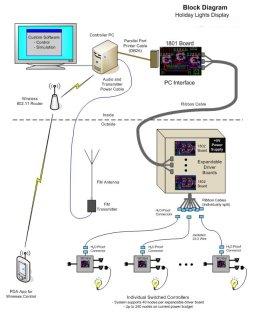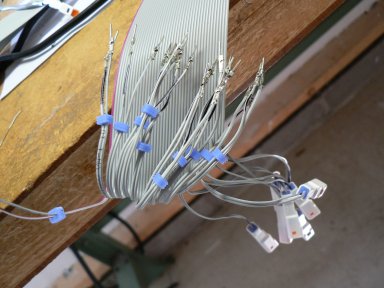Overview

The lighting display was powered by custom hardware and software. At the center of it all was a computer running special software. This software was programmed with individual sequences associated with each song. Each sequence defines separate on/off patterns associated with each strand of lights. The image to the right shows an overview of the system we designed from scratch.
The computer was directly connected to custom hardware built especially for this display. This hardware turned on and off the individual channels when commanded by the software. In all, three different custom circuit boards were used to control the lights. The system supported two variations of the final relay board, for a total of four custom boards.
The display also used a low power FM transmitter used to broadcast the music. This transmitter was connected to the computer's speaker output so that the software could control the music. The transmitter made it possible for viewers to tune their vehicle's radios to a specific station to listen to the music that the lights are synchronized to. There were no exterior speakers associated with the display. This was decided to avoid disturbing anyone.
The FM transmitter was the only commercial product used in our display aside from the lights themselves. All other components were designed and built from scratch. This included both the software and hardware that controls the lights.
A provision was also designed for wireless control of the system for initial testing. This was useful when working outside setting up the display. Custom software was written for a wireless PDA to communicate with the server software. This permits remote access to individual channels so that they can manually be turned on and off to test the correctness of wiring connections. The wireless option was disabled when not in use for security purposes.
